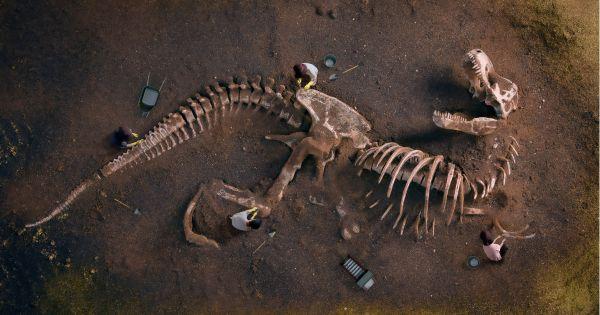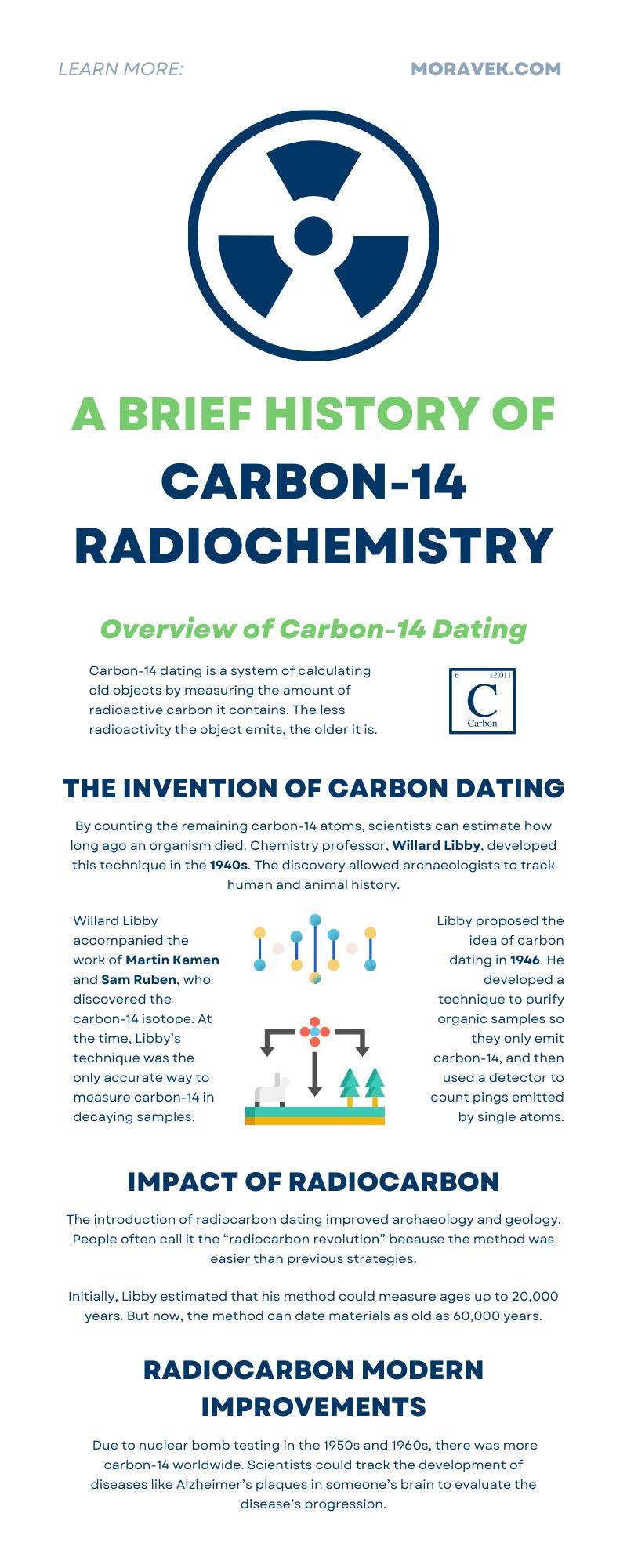
Carbon-14 radiochemistry refers to radiocarbon dating. It’s a scientific method that determines the age of organic samples. Explore the brief history of carbon-14 radiochemistry to understand its origins and impact on society.
Overview of Carbon-14 Dating
Carbon-14 is a radioactive isotope of carbon with six protons and eight neutrons. Carbon-14’s presence in organic material is the basis of radiocarbon dating. It’s a scientific method that can date archaeological, geological, and hydrogeological samples. Simply put, carbon-14 dating is a system of calculating old objects by measuring the amount of radioactive carbon it contains. The less radioactivity the object emits, the older it is. When plants and animals decay, they stop absorbing carbon-14. The remaining carbon can reveal their age.
The Invention of Carbon Dating
The invention of carbon dating combined chemistry and physics to develop a scientific method to determine the age of organic materials. In particular, it can determine the age of materials as old as 60,000 years. By counting the remaining carbon-14 atoms, scientists can estimate how long ago an organism died. Chemistry professor, Willard Libby, developed this technique in the 1940s. The discovery allowed archaeologists to track human and animal history.
Willard Libby accompanied the work of Martin Kamen and Sam Ruben, who discovered the carbon-14 isotope. Carbon-14 has a half-life of 5,730 years, meaning half of the atoms in a sample will change into other atoms as organic material decays.
Libby proposed the idea of carbon dating in 1946. He developed a technique to purify organic samples so they only emit carbon-14, and then used a detector to count pings emitted by single atoms. Scientists can use radiocarbon dating on any object that was once alive, including people, animals, and plants.
Libby and his colleagues took artifact samples from museums to test the accuracy of carbon dating. Since archaeologists knew the age of materials, they could compare results with Libby. The scientific technique became popular among other scientists. More than 30 radiocarbon labs opened by the 1960s to test alternative routes of radiocarbon dating.
At the time, Libby’s technique was the only accurate way to measure carbon-14 in decaying samples. Today, scientists use accelerator mass spectrometry to measure carbon-14 to achieve faster and more precise results.
Accurate Predictions
The concept of radiocarbon dating had to prove two of Libby’s assumptions. Radiocarbon dating is practical if the concentration of carbon-14 in the atmosphere is consistent for thousands of years and carbon-14 moves through the atmosphere and biosphere through the carbon cycle.
With limited historical information on cosmic radiation, Libby assumed that carbon-14 was constant. He determined that the rate of carbon-14 production was equal to its decay rate in organic material.
Furthermore, he had to estimate the amount of carbon-14 and compare it to the remaining carbon isotopes.
Libby concluded a ratio of one carbon-14 atom per every 10 billion carbon atoms on Earth.
Libby also studied the movement of carbon through the carbon cycle. Ideally, the ratio of carbon-14 to other carbon isotopes is the same in a living organism as in the atmosphere.
However, Libby did not know the rates of carbon movement. That’s why Libby and his colleague calculated the carbon across oceans, the largest reservoir. Their results predicted that the distribution of carbon-14 matched with the carbon cycle.
Testing Radiocarbon Dating
The idea of radiocarbon dating relied on the hypothesis that an organism gets cut off from the carbon cycle once it dies. This creates a time capsule with a declining carbon-14 count. Libby would measure the amount of carbon-14 present in the sample and compare it to the last known half-life of carbon-14.
Some of Libby’s first test objects were samples of redwood and fir trees, the age of which scientists determined by counting their annual growth rings. He also sampled a piece of timber from ancient Egyptian boats (an object whose age the archeologist knew).
During testing, Libby made a graph comparing the known age of artifacts with the estimated age from radiocarbon dating. His results were within a narrow range of the known ages, proving the accuracy of radiocarbon dating.
Impact of Radiocarbon
The introduction of radiocarbon dating improved archaeology and geology. People often call it the “radiocarbon revolution” because the method was easier than previous strategies. For example, field researchers would compare the layers of an artifact’s site to predict the material’s age. They didn’t have a precise numerical measure. Fortunately, radiocarbon dating was the first objective dating method—attaching approximate dates to organic remains.
Archaeologists discovered many things with radiocarbon dating because they could date manufactured artifacts from different continents. As professionals spent less time determining artifact ages, they were able to study other things like the evolution of human behavior.
Initially, Libby estimated that his method could measure ages up to 20,000 years. But now, the method can date materials as old as 60,000 years.
Limitations of Carbon-14 Dating
It’s important to understand that all dating techniques have limitations. Radiocarbon dating only works on organic matter up to 60,000 years old.
In the past, the method required 10 to 100 grams of an object to test the material. Depending on the size of the artifacts, some professionals couldn’t perform radiocarbon dating. Fortunately, newer strategies allow people to use less material (around 20 to 50 milligrams).
Furthermore, it’s easy to contaminate radiocarbon samples. People need clean and well-preserved artifacts to determine their age. Even specs of dirt can significantly throw off results.
Current preservation techniques make it easier for archaeologists and geologists to safeguard samples.
Radiocarbon Modern Improvements
As mentioned, people use accelerator mass spectrometry to measure carbon-14 because it’s faster. Technological and analytical advances make processes more precise. Please note that most dating models include an error of margin to give an estimate of sample age. However, modern improvements shorten the error margin. As a result, scientists achieve accurate results.
Human Health Advancements
Regarding human health, radiocarbon isotopes help scientists study the body, its functions, and diseases. Due to nuclear bomb testing in the 1950s and 1960s, there was more carbon-14 worldwide. Scientists could track the development of diseases like Alzheimer’s plaques in someone’s brain to evaluate the disease’s progression.
Radiocarbon isotopes can also track drug responses in the body. For example, doctors can track a patient’s response to chemotherapy or understand how cancer metastasizes.
From the brief history of carbon-14 radiochemistry, you can understand the impact of this scientific strategy. Thanks to Willard Libby, archeologists and geologists can determine the age of artifacts. Additionally, doctors can study the human body better.
Moravek supports the advancement of science and health through custom organic synthesis. We provide synthesis of radiolabeled, stable-labeled, and non-labeled compounds for clinical and non-clinical research. Get in touch with us today!

